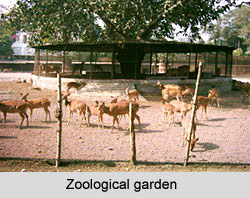The zoological garden is located in the Belvedere road in Kolkata. The zoological garden was established in 1875, and is spread extensively over nearly 100 acres of land. It is considered to be the one of the largest and the oldest zoos of India having vast reserve rare varieties of flora and the animal kingdom. It has been accredited for being the home of some endangered species of animals and interesting creatures. It is a bird watchers paradise in a word as well.
The zoological gardens came into existence due to the urge of the Burra Sahibs and the quintessential Bengali Babus who wished to have a zoological garden as their European counterpart in Kolkata. The period of 19th century marks the Bengal renaissance, which established Bengal as a very  happening place as it was also the capital. Therefore the need to have something, which the Indians could be proud of, gave rise to the gardens and was royally inaugurated on the 1st of January 1876, by King Edward VII. Recognized as the first zoo in the whole of Asia, this place has a special significance in the history of India.
happening place as it was also the capital. Therefore the need to have something, which the Indians could be proud of, gave rise to the gardens and was royally inaugurated on the 1st of January 1876, by King Edward VII. Recognized as the first zoo in the whole of Asia, this place has a special significance in the history of India.
The zoo, which continues to be a part of the British heritage in India, is one of the most widely visited places in Kolkata attracting not only children but also the old. It has many special attractions in the zoo, which has been a subject of curiosity among the crowd. The zoo has the credit of bringing back the rare Manipur Brow Antlered Deer from near extinction. The zoo was the first to have bred Giraffes and has produced Tigions and Litigons as a coss breeding accomplishment.
 As soon as we enter into the garden we get to see a huge variety of flowers and rarest of the animals, like the `White Tiger`, which is endangered and under the threat of extinction, a 250 year-old giant Tortoise, which is believed to be already more than 120 years when it moved to the Kolkata Zoo long back in the year 1876. There are two new members in the zoo, which are the two hippos that can be found in an exclusive 2,700 sq. meter open-air enclosure. In the artificial lake inside the zoo, seem to be attracting very rare species of birds. It is only during the winter months that the migratory birds can be spotted in the zoo. This makes the zoo an ultimate paradise for bird lovers, and they can spend a long time admiring the avifauna of the place. The gardens also constitute a Snake House, a Children`s park apart from the above-mentioned attractions. The artificial lake provides an interesting site with birds flocking above and a charm overwhelms all who visits it.
As soon as we enter into the garden we get to see a huge variety of flowers and rarest of the animals, like the `White Tiger`, which is endangered and under the threat of extinction, a 250 year-old giant Tortoise, which is believed to be already more than 120 years when it moved to the Kolkata Zoo long back in the year 1876. There are two new members in the zoo, which are the two hippos that can be found in an exclusive 2,700 sq. meter open-air enclosure. In the artificial lake inside the zoo, seem to be attracting very rare species of birds. It is only during the winter months that the migratory birds can be spotted in the zoo. This makes the zoo an ultimate paradise for bird lovers, and they can spend a long time admiring the avifauna of the place. The gardens also constitute a Snake House, a Children`s park apart from the above-mentioned attractions. The artificial lake provides an interesting site with birds flocking above and a charm overwhelms all who visits it.
Hence the garden is the enclosure where not only we get to see the numerous rare species of animals and birds but also get a chance to be amidst nature which seems to be on the process of degradation. In a busy schedule people have been drawn away from the beauty of nature, which can be revisited in the zoological Gardens of Kolkata. The greenery and the wilderness around helps the younger generation to relate themselves to nature, arousing some attachment towards it which is in turn capable in enhancing bond between man and the animal species.



















